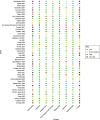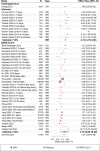Systematic review and meta-analysis of respiratory viral triggers for acute myocardial infarction and stroke
- PMID: 40570137
- PMCID: PMC12352309
- DOI: 10.1093/cvr/cvaf092
Systematic review and meta-analysis of respiratory viral triggers for acute myocardial infarction and stroke
Abstract
Respiratory viral infections may trigger acute cardiovascular events. However, relative pathogen-specific associations are poorly understood, limiting optimal preventive recommendations. The aim of this study was to systematically review the association between respiratory viruses with two primary outcomes, acute myocardial infarction (AMI) and stroke. We searched MEDLINE, PubMed, Embase, Cochrane, and Web of Science, from database inception to 26 August 2024. Analytical epidemiological studies of respiratory viruses identified by laboratory-confirmatory testing, involving human participants of any age in any country, were eligible for inclusion. Risk of bias was assessed using the Cochrane Collaboration approach. Data from studies of sufficient quality and homogeneity were pooled using a random-effects model. Certainty of the evidence was assessed for each identified viral trigger. Of 11 017 articles identified, we included a total of 48 studies published between 1978 and 2024. All were observational studies, of which 28 were suitable for quantitative synthesis. There was moderate-certainty evidence that influenza triggers AMI (incidence rate ratio, 5.37; 95% CI, 3.48-8.28; I2 = 69.4%). We found high-certainty evidence that influenza triggers stroke-influenza was associated with a 4.7-fold increased risk of stroke within the first 28 days following infection (incidence rate ratio, 4.72; 95% CI, 3.78-5.90; I2 = 0%). SARS-CoV-2 and cytomegalovirus may trigger stroke, while SARS-CoV-2, respiratory syncytial virus, and Coxsackie B were also identified as potential triggers for AMI. In this systematic review and meta-analysis, the findings suggest that common, often vaccine-preventable, respiratory viral infections are associated with an increased risk of acute cardiovascular events.
Keywords: Acute myocardial infarction; Respiratory virus; Stroke; Systematic review; Vaccine preventable.
© The Author(s) 2025. Published by Oxford University Press on behalf of the European Society of Cardiology.
Conflict of interest statement
Conflict of interest: All authors have submitted the ICMJE Form for Disclosure of Potential Conflicts of Interest. J.P.B. reports participation on a data and safety monitoring board for the Centre for Epidemic Preparedness and Innovation, academic institutions, and GSK, for which his employing institution (Murdoch Children’s Research Institute) is compensated for his time, as well as financial support for serving on the Australian Therapeutic Goods Administration Advisory Committee on Vaccines, outside the submitted work. All other authors report no potential conflicts.
Figures





References
-
- Libby P, Buring JE, Badimon L, Hansson GK, Deanfield J, Bittencourt MS, Tokgözoğlu L, Lewis EF. Atherosclerosis. Nat Rev Dis Primer 2019;5:56. - PubMed
-
- Institute for Health Metrics and Evaluation (IHME) . Global Burden of Disease Study 2021. https://vizhub.healthdata.org/gbd-results/ (1 October 2004, date last accessed).
-
- Sipilä PN, Lindbohm JV, Batty GD, Heikkilä N, Vahtera J, Suominen S, Väänänen A, Koskinen A, Nyberg ST, Meri S, Pentti J, Warren-Gash C, Hayward AC, Kivimäki M. Severe infection and risk of cardiovascular disease: a multicohort study. Circulation 2023;147:1582–1593. - PubMed
-
- Zimmerman RK, Balasubramani GK, D’Agostino HEA, Clarke L, Yassin M, Middleton DB, Silveira FP, Wheeler ND, Landis J, Peterson A, Suyama J, Weissman A, Nowalk MP. Population-based hospitalization burden estimates for respiratory viruses, 2015–2019. Influenza Other Respir Viruses 2022;16:1133–1140. - PMC - PubMed
Publication types
MeSH terms
Grants and funding
LinkOut - more resources
Full Text Sources
Medical
Miscellaneous

